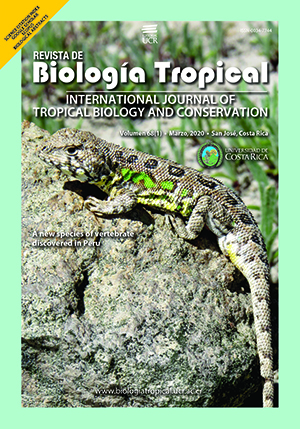Abstract
Coastal wetlands are sensitive ecosystems of high productivity because of the ecosystem services that they provide, like water purification, flood reduction, protection of marine coasts. In addition, coastal wetlands are places of great biological diversity. The objective of the present study was to determine the community structure of the benthic macroinvertebrates in relation to the spatial variations in the littoral zone of the Santa Rosa wetland, Lima, Peru. The study was divided into six bimonthly periods from August 2015 to June 2016, we established eight sampling sites: three sites in the main lagoon, two sites in the lagoon arm and two sites in isolated small pools. We carried out the sampling with a hand net of 250μm mesh aperture with 3 replicas for each site. The 8 sites evaluated were environmentally characterized, the physicochemical parameters of the water were recorded for each sampling site and the variations of the water level of the wetland in each sampling campaign were determined through a wooden post with marks in centimeters. We collected a total of 28655 organisms distributed in 76 species. Diptera and Coleoptera were the orders with greatest richness, with 24 and 19 species respectively. The most abundant species were Buenoa sp. (Hemiptera: Notonectidae), Ischnura sp. (Odonata: Coenagrionidae), Chironomus sp. and Goeldichironomus sp. (Diptera: Chironomidae); these four genera represented 62.43% of the total abundance. In the spatial variation, most sites shared the same structure and composition of macroinvertebrates; this was expected because they are connected to the main water body temporarily or permanently, which consequently gives them greater stability and resilience. Only the sites with less depth and extension on the one side and scarce aquatic vegetation and anthropogenic impact on the other side were separated from the general set. Despite the variety of impacts that the wetland suffers, it was observed that the deeper and more vegetated sites are more resilient than the areas exposed to impact and with less water and vegetation. On the other hand, the physicochemical parameters of water at one site (E1) differentiate the community in the absence of impact.

This work is licensed under a Creative Commons Attribution 4.0 International License.
Copyright (c) 2020 Rodolfo Mauricio Castillo Velásquez, Ana Asunción Huamantinco Araujo

